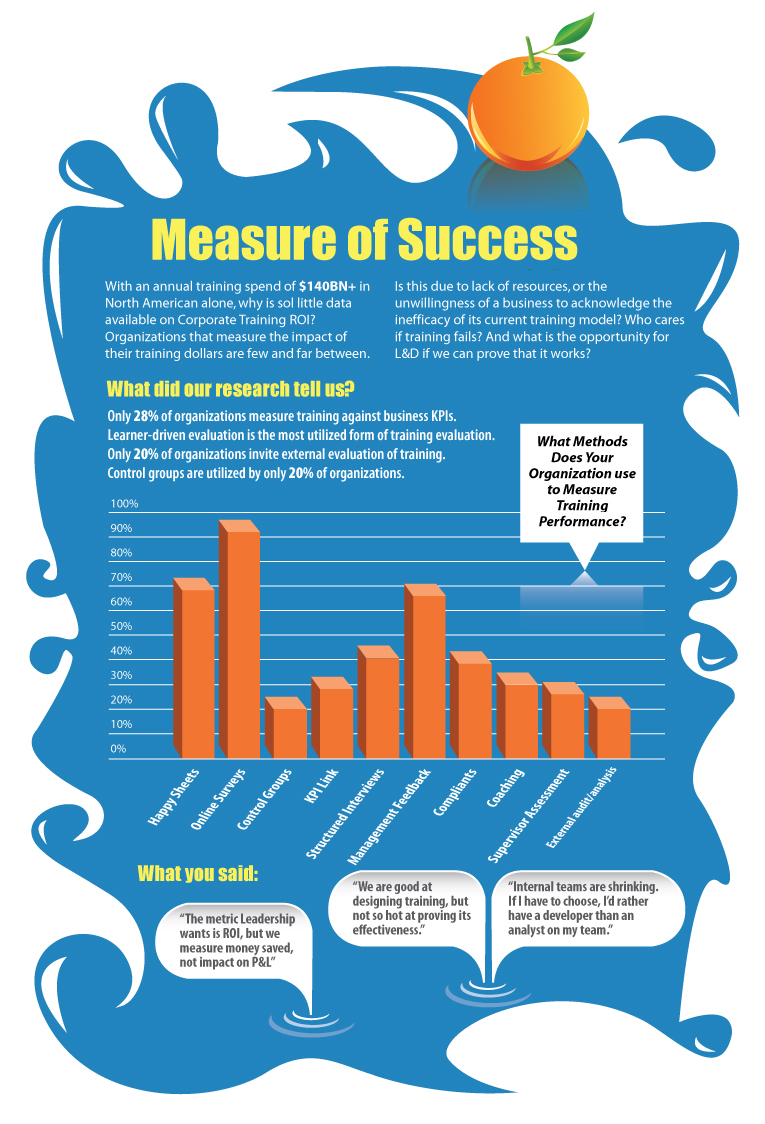In keeping with our monthly theme, John O’ Brien returns, this time focusing on return on investment.
Following a significant reduction in budgets for training in recent years due to the recession, organisations globally are once again focusing heavily on training as a means of improving performance and increasing ROI. Training Industry reported in 2013 that corporate and Government spend for training activities in North America alone was $141.7bn. This level of investment is clear proof of the value that companies place on training as a step toward achieving their business goals.
But are organisations actually measuring the performance of their training? And if so, what steps are they taking? In 2014, qualitative research was carried out among senior corporate learning and development professionals to determine what blended learning would look like in 2015. One of the key questions the research raised was, how can training ROI be effectively measured?
Here are the main findings of this survey-driven research regarding measurement and evaluation of corporate training:
Measurement is rare
The research revealed that only 28% of organisations measure training against business KPIs. Considering the level of investment that many organisations are making, this is a major concern. How can investment in training be truly justified if the results are not measured against the business objectives? Every business can agree that employees need training to develop required knowledge and role-specific skills, but if the short- and long-term impact of their training on the business as a whole is not tracked and analysed, the level of financial success from training cannot be determined.
Focus on learner-driven evaluation
The majority of organisations that do measure training tend to focus on the how well the individual employees perform in their roles. But the overall success of their training initiatives seems to be given a lot less attention. What are the reasons for this?
They include:
-
Unwillingness to assign training evaluation budgets
-
Lack of standard measurement processes in many organisations
-
Focus on the present and the future with reluctance of L&D departments to look at ‘yesterday’s results’
External evaluation of training is rare
Only 20% of respondents confirmed that their organisations made outsourced evaluation of training. This is primarily due to the lack of budget. In some cases also, organisations are not happy to use external parties to assess their business and prefer to do all evaluation internally.
Control groups are underused
We found that only 20% of survey respondents use control groups to test the effectiveness of training. Control groups are frequently used to determine the success of products and services. Training should be no different.
For example, one employee in every 10 could be left without any training in their job. Their performance could be monitored and evaluated against that of an employee who has received training. This is a simple and cost-effective way of assessing just how effective training is.

John O’ Brien is digital marketing executive at Interactive Services, an award-winning developer of custom elearning and blended solutions for global Fortune 500 companies. He has been working in sales and marketing for over 10 years. His skills range from blogging to search engine optimisation and web design. John can be contacted @Learn_IS or via LinkedIn. If you would like to learn more about research on measurement of training from ROI, download their whitepaper now: Blended Learning 2015: The Future of Blended Learning
In keeping with our monthly theme, John O' Brien returns, this time focusing on return on investment.
Following a significant reduction in budgets for training in recent years due to the recession, organisations globally are once again focusing heavily on training as a means of improving performance and increasing ROI. Training Industry reported in 2013 that corporate and Government spend for training activities in North America alone was $141.7bn. This level of investment is clear proof of the value that companies place on training as a step toward achieving their business goals.
But are organisations actually measuring the performance of their training? And if so, what steps are they taking? In 2014, qualitative research was carried out among senior corporate learning and development professionals to determine what blended learning would look like in 2015. One of the key questions the research raised was, how can training ROI be effectively measured?
Here are the main findings of this survey-driven research regarding measurement and evaluation of corporate training:
Measurement is rare
The research revealed that only 28% of organisations measure training against business KPIs. Considering the level of investment that many organisations are making, this is a major concern. How can investment in training be truly justified if the results are not measured against the business objectives? Every business can agree that employees need training to develop required knowledge and role-specific skills, but if the short- and long-term impact of their training on the business as a whole is not tracked and analysed, the level of financial success from training cannot be determined.
Focus on learner-driven evaluation
The majority of organisations that do measure training tend to focus on the how well the individual employees perform in their roles. But the overall success of their training initiatives seems to be given a lot less attention. What are the reasons for this?
They include:
Unwillingness to assign training evaluation budgets
Lack of standard measurement processes in many organisations
Focus on the present and the future with reluctance of L&D departments to look at 'yesterday’s results'
External evaluation of training is rare
Only 20% of respondents confirmed that their organisations made outsourced evaluation of training. This is primarily due to the lack of budget. In some cases also, organisations are not happy to use external parties to assess their business and prefer to do all evaluation internally.
Control groups are underused
We found that only 20% of survey respondents use control groups to test the effectiveness of training. Control groups are frequently used to determine the success of products and services. Training should be no different.
For example, one employee in every 10 could be left without any training in their job. Their performance could be monitored and evaluated against that of an employee who has received training. This is a simple and cost-effective way of assessing just how effective training is.

John O' Brien is digital marketing executive at Interactive Services, an award-winning developer of custom elearning and blended solutions for global Fortune 500 companies. He has been working in sales and marketing for over 10 years. His skills range from blogging to search engine optimisation and web design. John can be contacted @Learn_IS or via LinkedIn. If you would like to learn more about research on measurement of training from ROI, download their whitepaper now: Blended Learning 2015: The Future of Blended Learning




